Bregenz
Bregenz (German pronunciation: [ˈbʁeːgɛnt͡s] (![]()
Bregenz | |
|---|---|
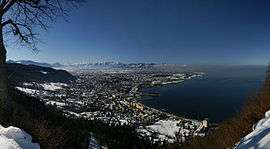 A view of Bregenz | |
 Coat of arms | |
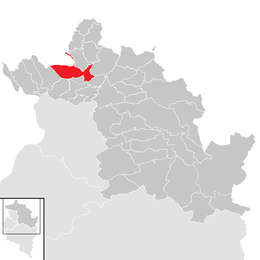 Location in the district | |
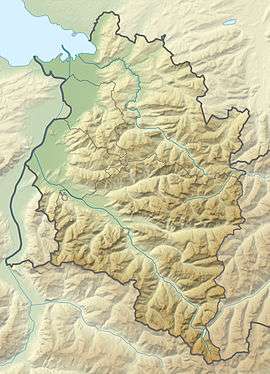 Bregenz Location within Vorarlberg 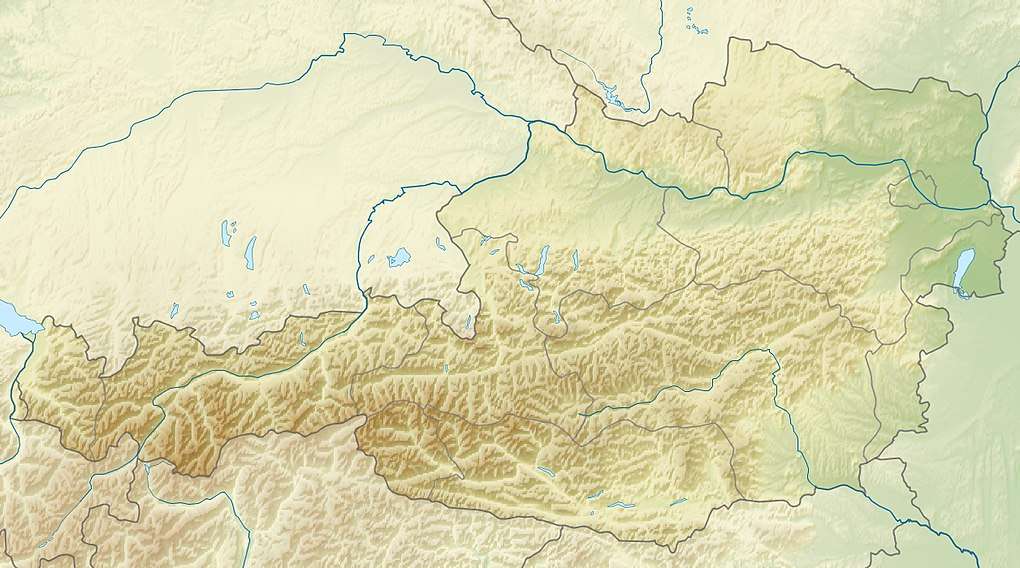 Bregenz Location within Austria | |
| Coordinates: 47°30′18″N 09°44′57″E | |
| Country | |
| State | Vorarlberg |
| District | Bregenz |
| Government | |
| • Mayor | Markus Linhart (ÖVP) |
| Area | |
| • Total | 29.5 km2 (11.4 sq mi) |
| Elevation | 427 m (1,401 ft) |
| Population (2018-01-01)[2] | |
| • Total | 29,806 |
| • Density | 1,000/km2 (2,600/sq mi) |
| Time zone | UTC+1 (CET) |
| • Summer (DST) | UTC+2 (CEST) |
| Postal code | 6900 |
| Area code | 05574 |
| Vehicle registration | B |
| Website | www.bregenz.at |
Bregenz is located on a plateau falling in a series of terraces to the lake at the foot of Pfänder mountain. It is a junction of the arterial roads from the Rhine valley to the German Alpine foothills, with cruise ship services on Lake Constance.
It is famous for the annual summer music festival Bregenzer Festspiele, as well as the dance festival Bregenzer Spring.
History
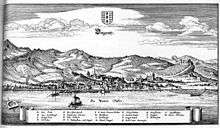
The first settlements date from 1500 BC. The Brigantii are mentioned by Strabo as a Celtic sub-tribe in this region of the Alps.[3] In the 5th century BC, the Celts settled at Brigantion, which became one of their most heavily fortified locations. After a series of battles in 15 BC, the Romans conquered Brigantion and the city became a Roman camp. It was conferred the status of a municipality (Brigantium) around 50 AD and was the seat of the Roman admiralty for Lake Constance. In 259/60 Brigantium was destroyed by the Alemanni, Germanic peoples who settled in the area in around 450.
From 610 to 612 Saint Columbanus and Saint Gall worked as missionaries in Bregenz. From 917 onwards the castle served as a residence of the Udalrichinger (ruling dynasty of Vorarlberg), who called themselves Counts of Bregenz. The house died out around 1150. The son of the first Ulrich was Saint Gebhard, born in 947. He became the Bishop of Konstanz. In around 1170 Hugo of Tübingen (Montfort) founded a town settlement (first documented in 1249), enlarged it in the 13th and 14th centuries and from 1650 to 1652.[4]
The city was sold in 1451, and again in 1523, to the Habsburgs and continued under Austrian rule, with a brief occupation by Swedish forces under Carl Gustaf Wrangel during the 30 Years' War, until the 19th century. Bregenz was under Bavarian rule from 1805 to 1814. From 1842 to 1850, the harbour on Lake Constance was built, then enlarged in 1883 and from 1889–1891, and Austrian ship service was inaugurated in 1884. Railway services have existed since 1872, and since 1884 across the Arlberg massif.
Since 1726, Bregenz has been the main seat of Austrian administration in Vorarlberg (Obervogtei, in 1786 Kreisamt, since 1861 seat of the Landtag, since 1918 seat of the Landeshauptmann). Rieden-Vorkloster and Fluh were incorporated into Bregenz in 1919 and 1946, respectively. The town was bombed by the Allies in 1945, and 72 houses were destroyed.
| Largest groups of foreign residents[5] | |
| Nationality | Population |
|---|---|
| 1,329 | |
| 1,035 | |
| 422 | |
| 396 | |
| 223 | |
Population
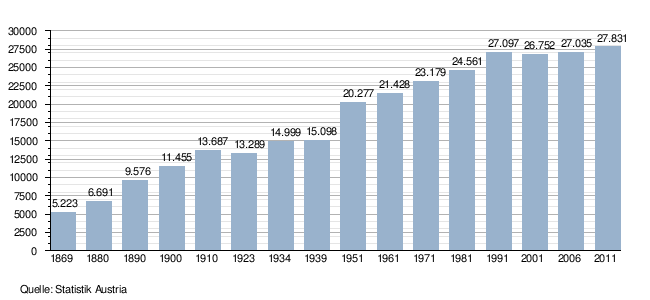
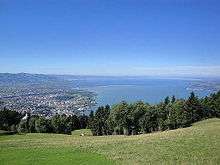
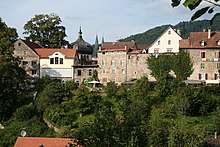
Main sights
Upper town
- Remains from the 13th and 16th centuries
- Town walls
- Old town hall (1662)
- Martinsturm (Martin's Tower). Originally built by the Romans, it has a chapel with frescoes dating from 1362. Between 1599 and 1601 an additional storey was added. It has the largest bulb-shaped Baroque steeple in Central Europe, and houses the Museum of Military History.
- Gothic parish church of St Gall: its Romanesque foundations date from before 1380, but it was rebuilt around 1480. Around 1737 it was converted to a Baroque style.
- Herz-Jesu parish church (1905–1908).
Lower town
- Town hall, built in 1686 (façade from 1898)
- Gothic Seekapelle (Lake Chapel)
- Landhaus (built from 1973 to 1982 by W. Holzbauer)
- Former Kornhausmarkt (built 1838 to 1940, altered 1951 to 1955); it now houses a theatre
- Protestant church of the Sacred Cross (1862–1864)
- Church of St Kolumban (1962–1966)
- Kunsthaus Bregenz (1991–1997) (modern art museum)
- Tourismushaus (tourist centre) (1994–1998).
Sights in the district of Vorkloster include the Maria Hilf parish church (1925–1931, by C. Holzmeister, interior from 1980) and the Cistercian monastery of Mehrerau.
On the Gebhardsberg rock are remains of the fortress of Hohenbregenz (destroyed by the Swedes in 1647).
Businesses and services
Government
Bregenz is the seat of the Vorarlberg State Assembly (Landtag), and of most of the provincial authorities/institutions of Vorarlberg (e.g. school superintendant, police headquarters, department of human resources development (AMS), Office for Environmental Protection, Chamber of Labour, Economics Chamber, Chamber of Agriculture, Chamber of Pharmacists, military regional headquarters, military garrison, one of the main hospitals of the province (Landeskrankenhaus), as well as a sanatorium, farmers' health and social insurance office, VLV (Mutual Fire Insurance Institute).
Consulates
A consulate-general of Turkey,[6] and honorary consulates of Belarus, France, Germany, Hungary, Norway, and Switzerland are located in Bregenz. Honorary consulates of Finland and the United Kingdom are located in nearby Lauterach, and an honorary consulate of Brazil in nearby Hard.[7]
Schools and the arts
Bregenz is home to four Gymnasium secondary schools, a commercial college (HAK), a technical college (HTL), upper secondary business schools (Höhere Lehranstalt für wirtschaftliche Berufe), three Berufsschulen (vocational schools), crafts colleges, the Academy of Social Sciences, and a nursing school. Others include: an adult education centre, school boarding houses, state archives, a state library, a state museum, Kunsthaus Bregenz (modern arts centre), Künstlerhaus (art centre), Thurn und Taxis Palace, five monasteries, Heimatwerk (autonomous institution fostering the manufacturing of traditional craft products), and various newspapers.
Public facilities
Festival and Congress centre, Theater am Kornmarkt, casino, harbour for sailing boats and yachts, cable car up onto the Pfänder mountain.
Economy
The economy is mainly dominated by small businesses in the services, trade and industry sectors: these include the textile industry (Wolford AG), fittings manufacturer Julius Blum GmbH, glass processing and machine construction.
Bi-seasonal tourism is important; a major attraction is the Bregenz Festival (since 1946, floating stage since 1949, modernised in 1979, Festival and Congress Hall in 1980), winter sports on the Pfänder mountain.
Culture
Bregenzer Festspiele
The annual summer music festival Bregenzer Festspiele is world-famous, taking place in July and August each year on and around a stage on Lake Constance. This festival attracts more than 150,000 people every year to Bregenz (2011: 166,453, 2016: 159,172) and has a budget of around EUR 20 million.[8] The program changes every two years. In 2016 the main opera performed was Turandot by Giacomo Puccini, in 2017 and 2018 Carmen by Georges Bizet. In 2021 the opera will be Rigoletto by Giuseppe Verdi.
In addition to playing on the lake stage, orchestral concerts and operas also take place in the adjacent festival theatre. There is also a children's and youth program during and before the beginning of the festival.
The lake stage (Seebühne) is the largest open-air theatre in the world, with an audience capacity of around 7,000.[9]
Bregenz Jazz Festival
Since 2014, the Bregenz Jazz Festival has been held every year in June at the Kornmarktplatz. It is the successor of the New Orleans Festival, which took place from 1999 to 2013, during the early summer, in the inner city of Bregenz, and which was no longer supported by the initiator Markus Linder. In addition to the change of name, there was also a musical genre change from blues to jazz. The location and the timing stayed roughly the same.[10]
Bregenzer Spring (Bregenzer Frühling)
Since 1987, Bregenzer Spring, a dance festival, has been held every year between March and May in the Festival Hall of Bregenz. Dance ensembles from all over the world perform their new productions, along with Austrian premieres. With a budget of around EUR 500,000 and up to 10,000 visitors, Bregenzer Spring is one of the most important dance festivals in Austria.[11]
Climate
| Climate data for Bregenz (1981–2010, extremes 1948–present) | |||||||||||||
|---|---|---|---|---|---|---|---|---|---|---|---|---|---|
| Month | Jan | Feb | Mar | Apr | May | Jun | Jul | Aug | Sep | Oct | Nov | Dec | Year |
| Record high °C (°F) | 17.5 (63.5) |
19.8 (67.6) |
25.8 (78.4) |
31.2 (88.2) |
32.5 (90.5) |
35.5 (95.9) |
37.5 (99.5) |
36.3 (97.3) |
34.2 (93.6) |
29.4 (84.9) |
25.4 (77.7) |
21.8 (71.2) |
37.5 (99.5) |
| Average high °C (°F) | 3.6 (38.5) |
5.0 (41.0) |
9.7 (49.5) |
14.2 (57.6) |
18.9 (66.0) |
21.9 (71.4) |
24.2 (75.6) |
23.5 (74.3) |
19.0 (66.2) |
14.0 (57.2) |
8.0 (46.4) |
4.6 (40.3) |
13.9 (57.0) |
| Daily mean °C (°F) | 0.4 (32.7) |
1.1 (34.0) |
5.0 (41.0) |
9.2 (48.6) |
14.1 (57.4) |
17.3 (63.1) |
19.2 (66.6) |
18.3 (64.9) |
14.2 (57.6) |
10.0 (50.0) |
4.7 (40.5) |
1.6 (34.9) |
9.6 (49.3) |
| Average low °C (°F) | −1.6 (29.1) |
−1.1 (30.0) |
2.3 (36.1) |
5.4 (41.7) |
9.9 (49.8) |
13.0 (55.4) |
15.0 (59.0) |
14.7 (58.5) |
11.4 (52.5) |
7.7 (45.9) |
2.6 (36.7) |
−0.3 (31.5) |
6.6 (43.9) |
| Record low °C (°F) | −19.0 (−2.2) |
−23.2 (−9.8) |
−16.0 (3.2) |
−4.7 (23.5) |
−1.8 (28.8) |
2.6 (36.7) |
4.3 (39.7) |
5.4 (41.7) |
2.1 (35.8) |
−3.2 (26.2) |
−10.1 (13.8) |
−15.2 (4.6) |
−23.2 (−9.8) |
| Average precipitation mm (inches) | 71 (2.8) |
75 (3.0) |
100 (3.9) |
114 (4.5) |
146 (5.7) |
182 (7.2) |
191 (7.5) |
177 (7.0) |
148 (5.8) |
105 (4.1) |
108 (4.3) |
102 (4.0) |
1,521 (59.9) |
| Average snowfall cm (inches) | 22 (8.7) |
24 (9.4) |
13 (5.1) |
3 (1.2) |
0 (0) |
0 (0) |
0 (0) |
0 (0) |
0 (0) |
0 (0) |
8 (3.1) |
19 (7.5) |
88 (35) |
| Average relative humidity (%) (at 14:00) | 76.4 | 72.0 | 62.9 | 57.5 | 58.8 | 60.0 | 60.8 | 63.4 | 68.4 | 74.2 | 77.4 | 77.7 | 67.5 |
| Source: Central Institute for Meteorology and Geodynamics[12][13][14][15][16][17] | |||||||||||||
| Climate data for Bregenz (1971–2000) | |||||||||||||
|---|---|---|---|---|---|---|---|---|---|---|---|---|---|
| Month | Jan | Feb | Mar | Apr | May | Jun | Jul | Aug | Sep | Oct | Nov | Dec | Year |
| Record high °C (°F) | 17.0 (62.6) |
18.4 (65.1) |
25.8 (78.4) |
26.9 (80.4) |
31.4 (88.5) |
34.6 (94.3) |
36.6 (97.9) |
35.3 (95.5) |
34.2 (93.6) |
27.4 (81.3) |
25.2 (77.4) |
21.8 (71.2) |
36.6 (97.9) |
| Average high °C (°F) | 3.4 (38.1) |
4.9 (40.8) |
9.5 (49.1) |
13.3 (55.9) |
18.5 (65.3) |
21.3 (70.3) |
23.7 (74.7) |
23.3 (73.9) |
19.2 (66.6) |
13.3 (55.9) |
7.6 (45.7) |
4.6 (40.3) |
13.6 (56.5) |
| Daily mean °C (°F) | 0.6 (33.1) |
1.5 (34.7) |
5.2 (41.4) |
8.5 (47.3) |
13.5 (56.3) |
16.4 (61.5) |
18.7 (65.7) |
18.2 (64.8) |
14.4 (57.9) |
9.7 (49.5) |
4.6 (40.3) |
1.8 (35.2) |
9.4 (48.9) |
| Average low °C (°F) | −1.6 (29.1) |
−0.9 (30.4) |
2.2 (36.0) |
4.8 (40.6) |
9.3 (48.7) |
12.2 (54.0) |
14.5 (58.1) |
14.4 (57.9) |
11.1 (52.0) |
7.2 (45.0) |
2.3 (36.1) |
−0.3 (31.5) |
6.3 (43.3) |
| Record low °C (°F) | −19.0 (−2.2) |
−14.4 (6.1) |
−15.6 (3.9) |
−3.5 (25.7) |
−0.3 (31.5) |
4.5 (40.1) |
7.0 (44.6) |
5.8 (42.4) |
2.2 (36.0) |
−3.4 (25.9) |
−9.7 (14.5) |
−14.8 (5.4) |
−19.0 (−2.2) |
| Average precipitation mm (inches) | 79.1 (3.11) |
76.0 (2.99) |
86.1 (3.39) |
124.2 (4.89) |
146.7 (5.78) |
203.4 (8.01) |
191.0 (7.52) |
162.3 (6.39) |
138.2 (5.44) |
108.5 (4.27) |
120.2 (4.73) |
94.6 (3.72) |
1,530.3 (60.25) |
| Average snowfall cm (inches) | 27.5 (10.8) |
23.4 (9.2) |
13.8 (5.4) |
5.7 (2.2) |
0.0 (0.0) |
0.0 (0.0) |
0.0 (0.0) |
0.0 (0.0) |
0.0 (0.0) |
0.4 (0.2) |
7.8 (3.1) |
22.6 (8.9) |
101.2 (39.8) |
| Average precipitation days (≥ 1.0 mm) | 11.1 | 8.9 | 10.6 | 12.8 | 13.1 | 15.3 | 15.3 | 12.7 | 10.6 | 9.9 | 11.2 | 11.3 | 140.8 |
| Average relative humidity (%) (at 14:00) | 76.6 | 72.9 | 62.3 | 57.9 | 57.3 | 59.5 | 59.6 | 62.1 | 65.6 | 73.6 | 76.1 | 77.3 | 66.7 |
| Mean monthly sunshine hours | 58.4 | 82.2 | 118.5 | 156.4 | 206.6 | 195.4 | 226.3 | 223.1 | 155.9 | 104.3 | 59.8 | 43.5 | 1,630.4 |
| Percent possible sunshine | 30.0 | 30.1 | 33.9 | 41.1 | 47.8 | 44.8 | 51.5 | 54.9 | 44.9 | 35.6 | 25.1 | 22.1 | 38.5 |
| Source: Central Institute for Meteorology and Geodynamics[18] | |||||||||||||
Sport
- A1 Bregenz HB is a handball team.
- SC Bregenz is the football team of the town, competing in the Austrian Regional League (Third Division).
Notable people
- Lukas Birk (born 1982) photographer[19]
- Wolf Dietrich von Raitenau (1559 in Lochau – 1617) Prince-Archbishop of Salzburg from 1587 to 1612
- Ignaz Anton von Indermauer (1759 in Tyrol – 1796) Landvogt and Kreishauptmann of Vorarlberg
- Johann Conrad Dorner (1810 in Egg – 1866), Austrian painter
- Josef Fessler (1813 in Lochau – 1872) Roman Catholic Bishop of Sankt Pölten and an authority on patristics
- Anton Gilbert Victor von Ebner, Ritter von Rofenstein (1842 in Bregenz – 1925) Austrian anatomist and histologist
- Johann Georg Hagen (1847 – 1930), Jesuit priest and astronomer
- Jodok Fink (1853 in Andelsbuch – 1929) Austrian farmer and politician, first Vice-Chancellor of Austria, from 1919 to 1920
- Max Sick (Maxick) (1882 – 1961), German strongman
- Valentin Feurstein (1885 – 1970) Austrian general in the Wehrmacht during World War II.
- Lorenz Bohler (1885 in Wolfurt – 1973), surgeon, one of the innovators of modern accident surgery. Member of Nazi Party
- Kaspar Albrecht (1889 in Au – 1970), architect and sculptor
- Irmfried Eberl (1910 – 1948), psychiatrist and commander of Treblinka extermination camp
- Hermann Gmeiner (1919 in Alberschwende – 1986) Austrian philanthropist and founder of SOS Children's Villages
- Fritz Mayer (1933-1988) politician, mayor of Bregenz from 1970 to 1988
- Karl Michael Vogler (1928 – 2009), actor, raised in Bregenz
- Sieghardt Rupp (1931–2015), actor
- Herbert Sausgruber (born 1946 in Bregenz) governor of the Austrian state of Vorarlberg
- İlber Ortaylı (born 1947 in Bregenz) Turkish historian and professor of history
- Günter Bischof (born 1953 in Mellau) Austrian-American historian and university professor
- Martin Pasi (born 1953 in Bregenz) Austrian-American organ builder
- Christina Simon (born Christina Ganahl in 1954 in Lochau) Austrian singer and composer.
- Ernst Fehr (born 1956 in Hard) Austrian behavioral economist and neuroeconomist
- Anton Amann (1956 in Bregenz – 2015) Austrian chemist and professor of chemistry at the Innsbruck Medical University
- Hans-Peter Martin (born 1957), journalist and politician, member of the European Parliament
- Stefan Sagmeister (born 1962), graphic designer
- Markus Gasser (born 1967) literary scientist and author
- Patrick Ortlieb (born 1967) former World Cup alpine ski racer and Olympic gold medalist
- Arno Geiger (born 1968 in Wolfurt) Austrian novelist
- Roman Rafreider (born 1969 in Bregenz) Austrian television host and journalist
- Christof Unterberger (born 1970) cellist and film composer
- Maria Anwander (born 1980) conceptual artist, specializes in performance and installation art
- Jakob Kasimir Hellrigl (born 1993) known as Candy Ken, rapper; combines a masculine appearance with feminine pop culture[20]
Twin towns
Bregenz is twinned with:


References
- "Dauersiedlungsraum der Gemeinden Politischen Bezirke und Bundesländer - Gebietsstand 1.1.2018". Statistics Austria. Retrieved 10 March 2019.
- "Einwohnerzahl 1.1.2018 nach Gemeinden mit Status, Gebietsstand 1.1.2018". Statistics Austria. Retrieved 9 March 2019.
- Strabo, Geographia Book IV Chap. 6
- B. Bilgeri, Bregenz, Geschichte der Stadt, Bd. 1, Wien-München, 1980
- "Ergebnisse der Registerzählung 2011". Statistik - Landesstatistik Vorarlberg. Archived from the original on 26 September 2014. Retrieved 26 September 2014.
- "Türkiye Cumhuriyeti Bregenz Başkonsolosluğu". Bregenz.bk.mfa.gov.tr. 25 February 2013. Retrieved 26 March 2013.
- "Foreign representations in Austria". Federal Ministry for European and International Affairs (Austria). Archived from the original on 22 May 2011. Retrieved 27 January 2009.
- "Facts and Figures | Bregenzer Festspiele". pressefoyer.at (in German). Retrieved 7 February 2017.
- "Bregenzer Festspiele". Bregenz (in German). 9 June 2015. Retrieved 7 February 2017.
- "From Jazz to Blues - Article in the local newspaper". Vorarlberger Nachrichten (in German). Retrieved 7 February 2017.
- "Bregenzer Frühling". Bregenz (in German). 15 July 2015. Retrieved 7 February 2017.
- "Klimamittel 1981–2010: Lufttemperatur" (in German). Central Institute for Meteorology and Geodynamics. Archived from the original on 21 October 2019. Retrieved 9 November 2019.
- "Klimamittel 1981–2010: Niederschlag" (in German). Central Institute for Meteorology and Geodynamics. Archived from the original on 29 December 2014. Retrieved 9 November 2019.
- "Klimamittel 1981–2010: Schnee" (in German). Central Institute for Meteorology and Geodynamics. Archived from the original on 29 December 2014. Retrieved 9 November 2019.
- "Klimamittel 1981–2010: Luftfeuchtigkeit" (in German). Central Institute for Meteorology and Geodynamics. Archived from the original on 21 October 2019. Retrieved 9 November 2019.
- "Klimamittel 1981–2010: Strahlung" (in German). Central Institute for Meteorology and Geodynamics. Archived from the original on 29 December 2014. Retrieved 9 November 2019.
- "Bregenz: Record mensili dal 1948" (in Italian). Central Institute for Meteorology and Geodynamics. Retrieved 10 November 2019.
- "Klimadaten von Österreich 1971–2000 – Vorarlberg-Bregenz" (in German). Central Institute for Meteorology and Geodynamics. Archived from the original on 12 October 2019. Retrieved 20 October 2019.
- Hirsch, Robert (March 2012). "Lukas Birk and the Afghan Box Camera Project" (PDF). Light Research. Retrieved 22 June 2020.
- PaperMag website retrieved Jan 2017
External links
| Wikimedia Commons has media related to Bregenz. |
| Wikisource has the text of the 1911 Encyclopædia Britannica article Bregenz. |
| Wikivoyage has a travel guide for Bregenz. |
- . Encyclopædia Britannica. 4 (11th ed.). 1911.
- http://www.bregenz.at Official site (in German)
- http://www.pfaender.at Official site (German/English/Italiano/Francais) of the Pfänder Mountain
- http://www.pfaenderbahn.at (in German)
- http://www.scbregenz.at Official site (in German) of local Football Club
- Bregenzer Festspiele/ Bregenze Festival website
- Bregenz Tourism Information